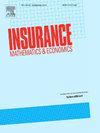Optimal valuation of variable annuity guaranteed lifetime withdrawal benefits with embedded top-up option
IF 2.2
2区 经济学
Q2 ECONOMICS
引用次数: 0
Abstract
This paper generalizes earlier works on the variable annuity guaranteed lifetime withdrawal benefits (VAGLWB) by introducing an embedded top-up option to the contract. This new feature/rider gives the policyholder an option to top-up the existing contract to a new one with larger withdrawal rate and reduced premium rate subject to paying a cost proportional to the current account value. The option is of American type which can be exercised at anytime prior to the maturity of the contract. In this work, we provide an analytical solution to the risk-neutral valuation for the VAGLWB with embedded top-up option from both policyholder's and insurer's perspective. From the perspective of policyholder, the valuation is formulated in terms of an optimal stopping problem of finding an exercise time of the option and the optimal account level at which the monetary value of the contract is maximized. The optimal solution to the stopping problem is derived under geometric Brownian motion dynamics of the equity price, the underlying investment vehicle of VAGLWB. The optimal value function (early exercise premium of the option) is given explicitly in terms of the confluent hypergeometric function satisfying both continuous and smooth pasting conditions. Furthermore, majorant and (super) harmonic properties of the value function are established to show the optimality of the solution. In the absence of top-up option, i.e., the new contract has equal withdrawal and premium rates with that of the existing contract, the results reduce to that of Feng and Jing (2017). Valuation from the insurer's perspective is discussed using equivalence principle between insurer's liabilities and fee incomes to find the fair value of the new premium rate. Finally, numerical examples are provided to exemplify the main results.
最优估值可变年金保证终身提取利益与嵌入式充值选项
本文通过在合同中引入嵌入的充值选项,总结了以往关于可变年金终身保证提取收益(VAGLWB)的研究成果。这项新功能/附加条款使投保人可以选择将现有合同充值为更高提款率和更低保费率的新合同,但须支付与经常账户价值成比例的成本。期权为美式期权,可在合同到期前的任何时间行使。本文从投保人和保险人的角度出发,对嵌入充值期权的VAGLWB风险中性估值问题提出了分析解决方案。从投保人的角度出发,将期权价值的最优终止问题(即寻找期权的行使时间)和合约货币价值最大化的最优账户水平表述为价值的最优终止问题。在VAGLWB的标的投资工具股票价格的几何布朗运动动力学下,导出了停止问题的最优解。用满足连续和平滑粘贴条件的合流超几何函数明确地给出了期权的最优价值函数(期权的早期行权溢价)。进一步,建立了值函数的主调和和(超)调和性质,证明了解的最优性。在没有充值选项的情况下,即新合同的提现率和保费率与现有合同相同,结果降低到Feng和Jing(2017)的结果。运用保险公司负债与费用收入的等价原则,从保险公司的角度进行评估,寻找新的保险费率的公允价值。最后,通过数值算例对主要结果进行了说明。
本文章由计算机程序翻译,如有差异,请以英文原文为准。
求助全文
约1分钟内获得全文
求助全文
来源期刊

Insurance Mathematics & Economics
管理科学-数学跨学科应用
CiteScore
3.40
自引率
15.80%
发文量
90
审稿时长
17.3 weeks
期刊介绍:
Insurance: Mathematics and Economics publishes leading research spanning all fields of actuarial science research. It appears six times per year and is the largest journal in actuarial science research around the world.
Insurance: Mathematics and Economics is an international academic journal that aims to strengthen the communication between individuals and groups who develop and apply research results in actuarial science. The journal feels a particular obligation to facilitate closer cooperation between those who conduct research in insurance mathematics and quantitative insurance economics, and practicing actuaries who are interested in the implementation of the results. To this purpose, Insurance: Mathematics and Economics publishes high-quality articles of broad international interest, concerned with either the theory of insurance mathematics and quantitative insurance economics or the inventive application of it, including empirical or experimental results. Articles that combine several of these aspects are particularly considered.
 求助内容:
求助内容: 应助结果提醒方式:
应助结果提醒方式:


